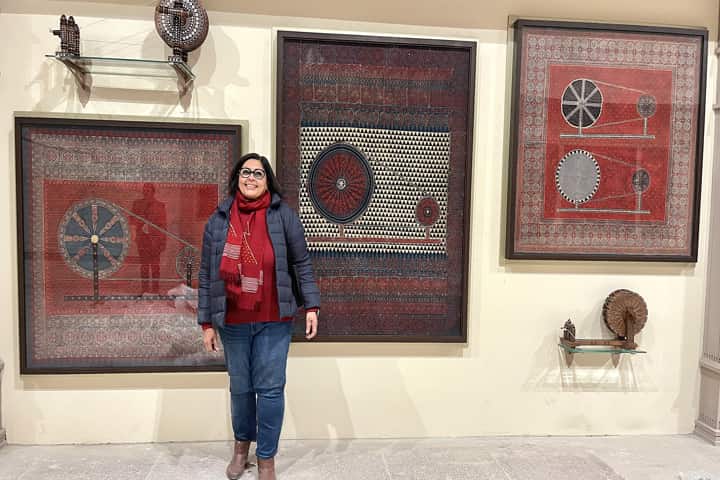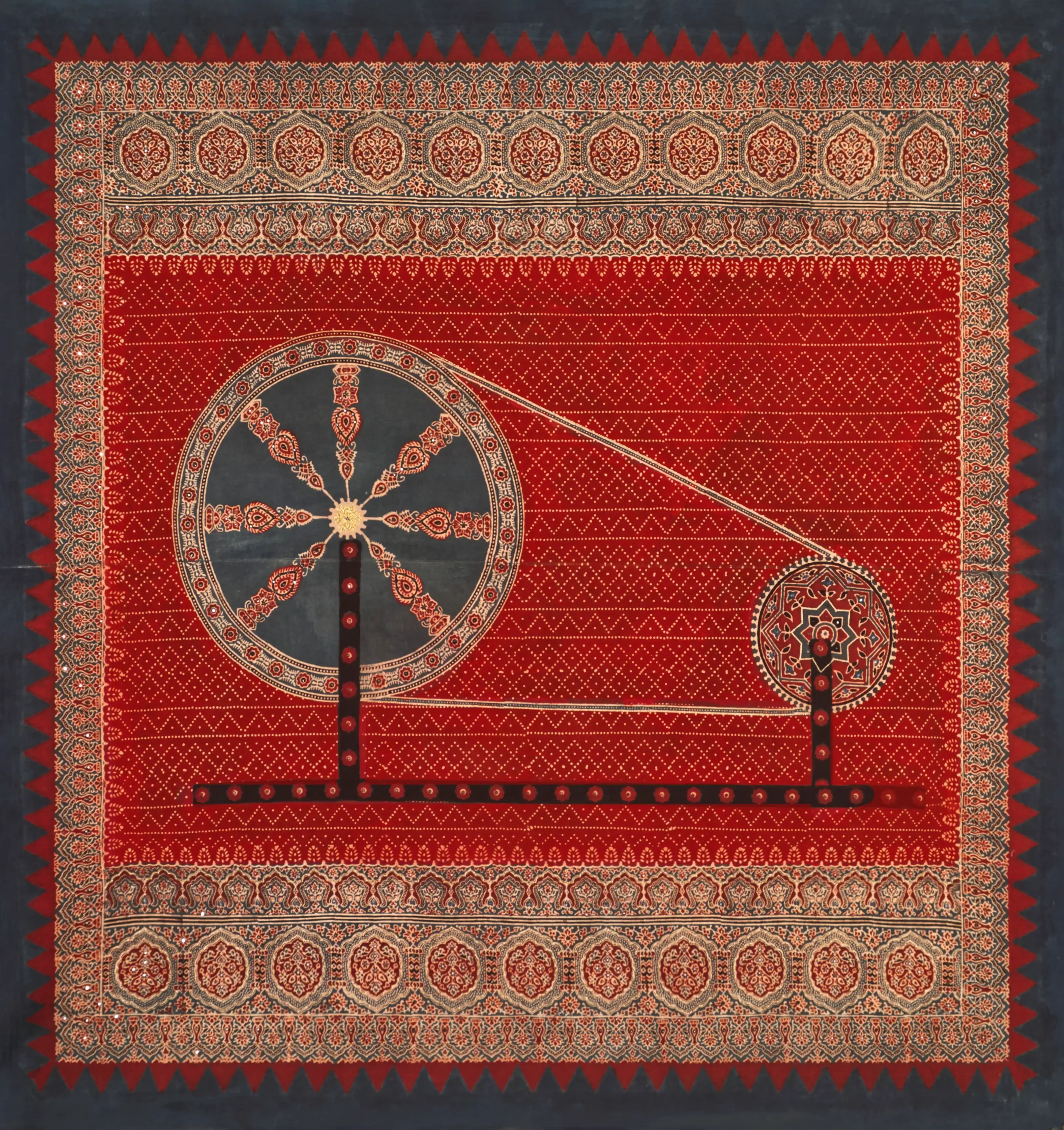

Artist Shelly Jyoti with her three artworks inspired by charkha that are adorning the new Parliament Building's Shilp Gallery
The new Parliament Building, inaugurated by Prime Minister Narendra Modi on May 28, 2023 goes beyond reflecting the aspirations and ambitions of India which has completed 75 years of Independence. It prominently displays Indian art, culture, and artworks of the country’s leading artists and artisans.
The Shilp Gallery designed by Jaya Jaitly, the President of Dastkari Haat at the new Parliament exhibits works of more than 350 artists in an eight-installation concept which is divided into eight themes. These are Gyan, Prakriti, Aastha, Ullas, Parv, Samrasta, Swavalamban and Yatra. Shelly Jyoti, a seasoned visual artist, fashion designer, and independent curator, has her installation, a triptych titled “Charkha – the Wheels of Swavalamban” displayed at this Gallery.
Thanking Jaitly who commissioned her artworks, Jyoti told India Narrative: “It’s a very special feeling because it’s a once in a century project to be associated with. It’s even more special because we are representing the present ethos of India which is Make in India.”


In a mail interview with India Narrative, she talks about the work, how it was inspired by Gandhiji and his philosophies and the challenges she faced.
Excerpts from the interview:
What made you choose Charkha for your artwork?
Charkha embodies the essence of self-reliance (swavalamban) while serving as a reminder of our hard-won freedom and the importance of preserving it. It connects our past with the present, spinning the threads of India’s long and complex history while standing for all the ideals and aspirations of a free nation.
How is the artwork inspired by India’s freedom struggle and Mahatma Gandhi’s philosophies?
Gandhi was challenging foreign goods during British rule and preached to spin yarn for half an hour each day symbolically advocating his ideology of self-sufficiency. The charkha motif also suggests Gandhi’s vision that hand production for community’s benefit could provide ordinary people across India an alternative to the extractive effects of industrial capitalism and as corrective to the ills of modern civilization. Spinning wheel, emerged metonymically as an emblem of self-sufficiency and nationalist independence through his philosophies of swadharma, sarvodaya, swadeshi and swaraj.
How relevant is charkha in today’s modern, industrialised and technology-driven India? Will it connect with Gen Z?
While today technology is fast changing the world, I feel it’s important to return to the roots of the past. Charkha will keep evolving its meaning as we progress in time, and bring its new relevance of self-sufficiency, sustainability, but it will forever symbolise what we had to struggle to get independence.
I think today’s generation is very conscious of culture and heritage and are delving more strongly with the past than a generation before. In my experience they are excited to see this kind of work using Khadi as canvas and incorporating a textile printing tradition to create an art scroll that has heritage as well as aesthetic appeal.
What do the charkhas in the three paintings symbolise?
One charkha or two charkhas (spinning wheel) symbolise unity, freedom, and self-sufficiency, reminding us of the Swadeshi Movement during India’s freedom struggle, when it stood for making our own products. Adding another dimension of creating two reflects the diversity of people, as a collective whole, strengthening the concept of Swavalamban.
What were the challenges you faced while creating this installation?
The reverse dye process of Ajrakh requires thinking about solids and voids in a way that is very challenging. Being able to envision the ideal outcome and being able to execute the steps needed to reach that outcome in the correct order are challenges I faced creating these artworks. The Ajrakh textile tradition is very laborious.
Nature plays a big role in the making of these artworks. The absorption of dye is dependent on the weather. The uncertainty of the output always looms large while in the process of printing, reprinting, dyeing and drying.
These works were created in July when temperatures soared up to 46 degrees in Bhuj. Post dyeing embellishment including Zardozi embroidery and mirror work which play an important role in raising the beautiful artwork was also challenging.
What are you working on next?
My new works explore the sordid history of indigo dye in colonial Bengal and Gandhi’s intervention as his first satyagraha on Indian soil, the Champaran movement in 1917-18. This exhibition expands research into indigo dye that connected the world through trade, plantation, forced labour, migration, and colonization. For this exhibition — invited by South Asia Institute of Chicago as a solo, mid-career retrospective and titled “Indigo: The ‘Blue Gold’,” — I have created 45 new Ajrakh artworks. It opens in July until December 2023.
Prime Minister Narendra Modi had a "fruitful conversation" with Finnish President Alexander Stubb on Wednesday…
US Vice President JD Vance is scheduled to visit India next week. He will meet…
In a first, Indian Railways has installed an ATM on a trial basis -- on…
Commerce Minister Piyush Goyal met a delegation from Elon Musk-owned satellite internet services company Starlink.…
The United States has enacted restrictions on the export of Nvidia's H20 chips to China,…
BusinessWire India QpiAI, a leader in quantum computing and generative AI, announced its First Quantum…